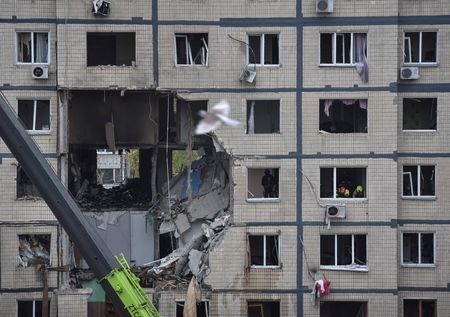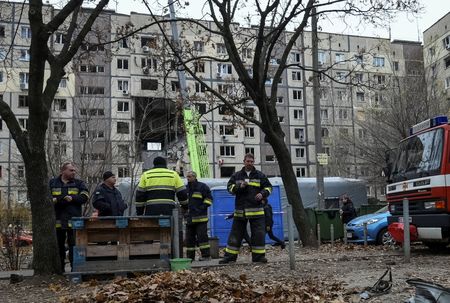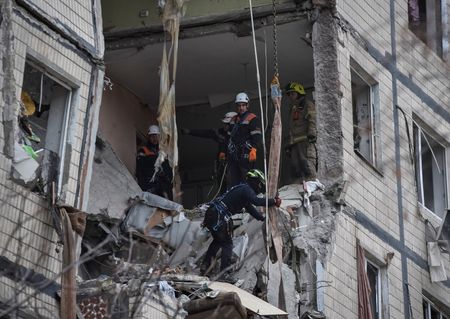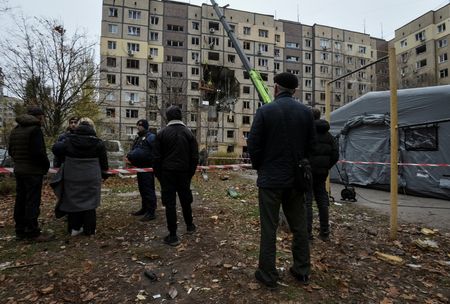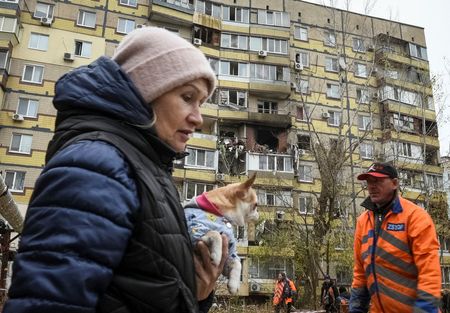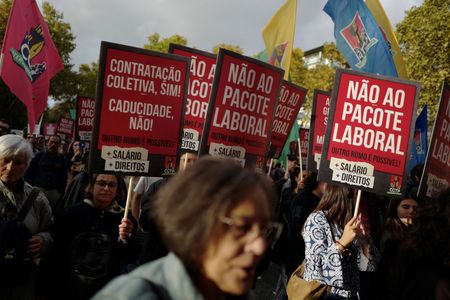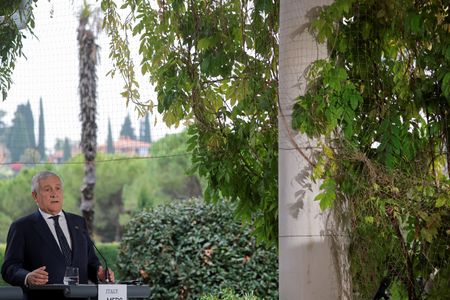By Olena Harmash
KYIV (Reuters) -Russia launched a barrage of drones and missiles in overnight attacks on Ukraine, targeting substations that supply two nuclear power plants and killing seven people, Ukrainian officials said on Saturday.
“Russia once again targeted substations that power the Khmelnytskyi and Rivne nuclear power plants,” Foreign Minister Andrii Sybiha said on X.
“These were not accidental but well-planned strikes. Russia is deliberately endangering nuclear safety in Europe.”
President Volodymyr Zelenskiy said Russia had launched more than 450 drones and 45 missiles.
Three people were killed and 12 were wounded in the city of Dnipro when a drone hit an apartment building. Three were killed in the southeastern Zaporizhzhia region and one in Kharkiv region farther north, regional officials said.
Energy facilities in the Kyiv, Poltava and Kharkiv regions were damaged, leaving thousands of people without power and water, Prime Minister Yulia Svyrydenko said. Officials in Poltava said power generators were used to provide water.
Russia’s Defence Ministry said earlier on Saturday that it had launched “a massive strike with high-precision long-range air, ground and sea-based weapons” on weapon production and gas and energy facilities in response to Kyiv’s strikes on Russia.
MINISTER SAYS POWER GRID STABILIZED
Energy Minister Svitlana Hrynchuk said emergency crews had stabilized the power grid, but warned consumers further power cuts were needed to allow work to proceed after the attacks.
“We are assessing the aftermath and coordinating what actions to take in order to find alternative power sources to ensure people get their power and heating back,” Hrynchuk said on national television.
News reports and unofficial social media accounts said blackouts persisted in at least two regions – Kharkiv in the northeast and Poltava in central Ukraine.
State-owned energy company Tsentrenergo said the attacks were the largest on its facilities since the start of the war in February 2022, and that it had halted operations at its plants in the Kyiv and Kharkiv regions.
“The last strike was not even a month ago and the enemy has now struck all our generating capacity at the same time. The stations are on fire!” Tsentrenergo, which generates about 8% of Ukraine’s power, said in a statement.
“Our generation is now zero.”
ZELENSKIY CALLS FOR MORE SANCTIONS PRESSURE
Zelenskiy said sanctions pressure should be intensified.
“For every Moscow strike on energy infrastructure – aimed at harming ordinary people before winter – there must be a sanctions response targeting all Russian energy, with no exceptions,” he said on the Telegram app.
Sybiha called for an urgent meeting of the International Atomic Energy Agency’s board of governors and urged China and India to pressure Russia to stop attacks on facilities that risk “a catastrophic incident.”
Since the start of its invasion, Russia has attacked the power sector as the need for heating grows. It has attacked gas facilities nine times within two months, according to the state firm Naftogaz.
Russia has also continued with its advance along the battlefield in recent weeks. Moscow said on Saturday that its forces made gains around the towns of Pokrovsk and Kupiansk, and had captured a tiny village in eastern Ukraine.
Kyiv has stepped up long-range drone and missile strikes inside Russia, hitting oil refineries, depots and logistics hubs it says feed the Kremlin’s war machine.
The attacks, Ukraine says, are legitimate self-defence in the war that Russia launched in February 2022.
The Ukrainian air force said 406 Russian drones and nine missiles had been shot down overnight into Saturday, and 26 Russian missiles and 52 drones had hit 25 sites.
(Reporting by Olena Harmash in Kyiv; Additional reporting by Oleksander Kozhukhar in Kyiv, Ron Popeski in Winnipeg and Lidia Kelly in Melbourne; Editing by Kevin Liffey, Rod Nickel)

